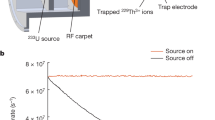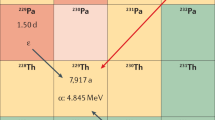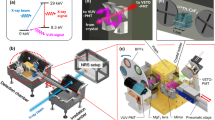Abstract
The radionuclide thorium-229 features an isomer with an exceptionally low excitation energy that enables direct laser manipulation of nuclear states. It constitutes one of the leading candidates for use in next-generation optical clocks1,2,3. This nuclear clock will be a unique tool for precise tests of fundamental physics4,5,6,7,8,9. Whereas indirect experimental evidence for the existence of such an extraordinary nuclear state is substantially older10, the proof of existence has been delivered only recently by observing the isomer’s electron conversion decay11. The isomer’s excitation energy, nuclear spin and electromagnetic moments, the electron conversion lifetime and a refined energy of the isomer have been measured12,13,14,15,16. In spite of recent progress, the isomer’s radiative decay, a key ingredient for the development of a nuclear clock, remained unobserved. Here, we report the detection of the radiative decay of this low-energy isomer in thorium-229 (229mTh). By performing vacuum-ultraviolet spectroscopy of 229mTh incorporated into large-bandgap CaF2 and MgF2 crystals at the ISOLDE facility at CERN, photons of 8.338(24) eV are measured, in agreement with recent measurements14,15,16 and the uncertainty is decreased by a factor of seven. The half-life of 229mTh embedded in MgF2 is determined to be 670(102) s. The observation of the radiative decay in a large-bandgap crystal has important consequences for the design of a future nuclear clock and the improved uncertainty of the energy eases the search for direct laser excitation of the atomic nucleus.
This is a preview of subscription content, access via your institution
Access options
Access Nature and 54 other Nature Portfolio journals
Get Nature+, our best-value online-access subscription
$29.99 / 30 days
cancel any time
Subscribe to this journal
Receive 51 print issues and online access
$199.00 per year
only $3.90 per issue
Buy this article
- Purchase on SpringerLink
- Instant access to full article PDF
Prices may be subject to local taxes which are calculated during checkout





Similar content being viewed by others
Data availability
The data that support the findings of this study are available from the corresponding author upon reasonable request. Source data are provided with this paper.
References
Peik, E. & Tamm, C. Nuclear laser spectroscopy of the 3.5 eV transition in Th-229. Euro. Phys. Lett. 61, 181 (2003).
Campbell, C. J. et al. Single-ion nuclear clock for metrology at the 19th decimal place. Phys. Rev. Lett. 108, 120802 (2012).
Beeks, K. et al. The thorium-229 low-energy isomer and the nuclear clock. Nat. Rev. Phys. 3, 238–248 (2021).
Flambaum, V. V. Enhanced effect of temporal variation of the fine structure constant and the strong interaction in 229Th. Phys. Rev. Lett. 97, 092502 (2006).
Peik, E. et al. Nuclear clocks for testing fundamental physics. Quant. Sci. Technol. 6, 034002 (2021).
Uzan, J.-P. Varying constants, gravitation and cosmology. Living Rev. Relativ. 14, 2 (2011).
Derevianko, A. & Pospelov, M. Hunting for topological dark matter with atomic clocks. Nat. Physics 10, 933–936 (2014).
Arvanitaki, A., Huang, J. & Van Tilburg, K. Searching for dilaton dark matter with atomic clocks. Phys. Rev. D 91, 015015 (2015).
Thirolf, P. G., Seiferle, B. & von der Wense, L. Improving our knowledge on the 229mThorium isomer: toward a test bench for time variations of fundamental constants. Ann. Phys. 531, 1800381 (2019).
Kroger, L. A. & Reich, C. W. Features of the low-energy level scheme of 229Th as observed in the alpha-decay of 233U. Nucl. Phys. A 259, 29–60 (1976).
von der Wense, L. et al. Direct detection of the 229Th nuclear clock transition. Nature 533, 47–51 (2016).
Thielking, J. et al. Laser spectroscopic characterization of the nuclear-clock isomer 229mTh. Nature 556, 321–325 (2018).
Seiferle, B., von der Wense, L. & Thirolf, P. G. Lifetime measurement of the 229mTh nuclear isomer. Phys. Rev. Lett. 118, 042501 (2017).
Seiferle, B. et al. Energy of the 229Th nuclear clock transition. Nature 573, 243–246 (2019).
Yamaguchi, A. et al. Energy of the 229Th nuclear clock isomer determined by absolute γ-ray energy difference. Phys. Rev. Lett. 123, 222501 (2019).
Sikorsky, T. et al. Measurement of the 229Th isomer energy with a magnetic microcalorimeter. Phys. Rev. Lett. 125, 142503 (2020).
Matinyan, S. Lasers as a bridge between atomic and nuclear physics. Phys. Rep. 298, 199–249 (1998).
von der Wense, L. & Seiferle, B. The 229Th isomer: prospects for a nuclear optical clock. Eur. Phys. J. A 56, 277 (2020).
Tkalya, E. V., Schneider, C., Jeet, J. & Hudson, E. R. Radiative lifetime and energy of the low-energy isomeric level in Th-229. Phys. Rev. C 92, 054324 (2015).
Minkov, N. & Pálffy, A. Reduced transition probabilities for the gamma decay of the 7.8 eV isomer in 229Th. Phys. Rev. Lett. 118, 212501 (2017).
Ruchowska, E. et al. Nuclear structure of 229Th. Phys. Rev. C 73, 044326 (2006).
Campbell, C. J., Radnaev, A. G. & Kuzmich, A. Wigner crystals of for optical excitation of the nuclear 229Th isomer. Phys. Rev. Lett. 106, 223001 (2011).
Rellergert, W. G. et al. Constraining the evolution of the fundamental constants with a solid-state optical frequency reference based on the 229Th nucleus. Phys. Rev. Lett.104, 200802 (2010).
Kazakov, G. A. et al. Performance of a 229Thorium solid-state nuclear clock. New J. Phys. 14, 083019 (2012).
Dessovic, P. et al. 229Thorium-doped calcium fluoride for nuclear laser spectroscopy. J. Phys. Condens. Matter 26, 105402 (2014).
Pimon, M. et al. DFT calculation of 229thorium-doped magnesium fluoride for nuclear laser spectroscopy. J. Phys. Condens. Matter 32, 255503 (2020).
Stellmer, S. et al. Toward an energy measurement of the internal conversion electron in the deexcitation of the 229Th isomer. Phys. Rev. C 98, 014317 (2018).
Stellmer, S., Schreitl, M. & Schumm, T. Radioluminescence and photoluminescence of Th:CaF2 crystals. Sci. Rep. 5, 15580 (2015).
Utter, S. B. et al. Reexamination of the optical gamma ray decay in 229Th. Phys. Rev. Lett. 82, 505–508 (1999).
Masuda, T. et al. X-ray pumping of the 229Th nuclear clock isomer. Nature 573, 238–242 (2019).
Verlinde, M. et al. Alternative approach to populate and study the 229Th nuclear clock isomer. Phys. Rev. C 100, 024315 (2019).
Nudat 3 Database (National Nuclear Data Center, 2023); https://www.nndc.bnl.gov/nudat3/.
Stellmer, S., Schreitl, M., Kazakov, G. A., Sterba, J. H. & Schumm, T. Feasibility study of measuring the 229Th nuclear isomer transition with 233U-doped crystals. Phys. Rev. C 94, 014302 (2016).
Hofsäss, H. & Lindner, G. Emission channeling and blocking. Phys. Rep. 201, 121–183 (1991).
Wahl, U. et al. Position-sensitive si pad detectors for electron emission channeling experiments. Nucl. Instrum. Meth. Phys. Res. A 524, 245–256 (2004).
Silva, M. R., Wahl, U., Correia, J. G., Amorim, L. M. & Pereira, L. M. C. A versatile apparatus for on-line emission channeling experiments. Rev. Sci. Instrum. 84, 073506 (2013).
Borge, M. J. G. & Jonson, B. ISOLDE past, present and future. J. Phys. G: Nucl. Part. Phys. 44, 044011 (2017).
Rubloff, G. W. Far-ultraviolet reflectance spectra and the electronic structure of ionic crystals. Phys. Rev. B 5, 662–684 (1972).
Thomas, J., Stephan, G., Lemonnier, J. C., Nisar, M. & Robin, S. Optical anisotropy of MgF2, in its UV absorption region. Phys. Stat. Sol. (B) 56, 163–170 (1973).
Ziegler, J. F., Ziegler, M. & Biersack, J. Srim - the stopping and range of ions in matter (2010). Nucl. Instrum. Meth. Phys. Res. B 268, 1818–1823 (2010). 19th International Conference on Ion Beam Analysis.
Beeks, K. The Nuclear Excitation of Thorium-229 in the CaF2 Environment. PhD thesis, TU Wien (2022).
Evaluated Nuclear Structure Data File (National Nuclear Data Center, 2023); https://www.nndc.bnl.gov/ensdf/.
David-Bosne, E. et al. A generalized fitting tool for analysis of two-dimensional channeling patterns. Nucl. Instrum. Meth. Phys. Res. B 462, 102–113 (2020).
Pereira, L., Vantomme, A. & Wahl, U. in Characterisation and Control of Defects in Semiconductors: Characterizing Defects with Ion Beam Analysis and Channeling Techniques (ed. Tuomisto, F.) Ch. 11 (The Institution of Engineering and Technology, 2019).
Kikunaga, H. et al. Half-life estimation of the first excited state of Th-229 by using alpha-particle spectrometry. Phys. Rev. C 80, 034315 (2009).
Tkalya, E. V., Zherikhin, A. N. & Zhudov, V. I. Decay of the low-energy nuclear isomer 229Thm(3/2+, 3.5 ± 1.0 eV) in solids (dielectrics and metals): a new scheme of experimental research. Phys. Rev. C 61, 064308 (2000).
Acknowledgements
We thank the ISOLDE collaboration and technical group at CERN for their extensive support and assistance. This work has received funding from Research Foundation Flanders (FWO, Belgium), from grant no. GOA/2015/010 (BOF KU Leuven) and from FWO and F.R.S.-FNRS under the Excellence of Science (EOS) programme (grant no. 40007501), the Portuguese Foundation for Science and Technology (FCT, project no. CERN/FIS-TEC/0003/2019), the Austrian Science Fund (FWF) project no. I5971 (REThorIC), the European Union’s Horizon 2020 research and innovation programme under the ENSAR2 grant agreement no. 654002, under the Marie Skłodowska-Curie grant agreement no. 101026762 and the European Research Council (ERC) under the Thorium Nuclear Clock agreement no. 856415 and under the LRC agreement no. 819957.
Author information
Authors and Affiliations
Contributions
P.V.D., M.H., L.M.C.P., Y.K., S.R., M.V., S.K., J.M. and A.V. conceived and planned the experiments. S.K. developed the VUV setup with help from H.D.W. and P.V.D.B. S.K. and P.C. prepared the VUV-spectroscopy experiments. J.M., U.W. and L.M.C.P. prepared the emission channelling experiments. C.M. grew the CaF2 thin films. S.K., J.M., M.A.-K., S.B., K.B., P.C., K.C., A.C., T.E.C., J.M.C., R.F., S.G., R.H., N.H., M.L., R.L., G.M., S.R., S.S., P.G.T., P.V.D., S.M.T., U.K., R.V. and U.W. performed the measurements. S.K., S.B., P.C. and S.S. analysed the VUV-spectroscopy data. J.M. analysed the emission channelling data. S.K., J.M., L.M.C.P., S.S. and P.V.D. prepared the manuscript. All authors provided critical feedback and helped shape the research, analysis and manuscript. This article results from the PhD thesis work of S.K. and J.M.
Corresponding author
Ethics declarations
Competing interests
The authors declare no competing interests.
Peer review
Peer review information
Nature thanks Iain Moore and the other, anonymous, reviewer(s) for their contribution to the peer review of this work. Peer reviewer reports are available.
Additional information
Publisher’s note Springer Nature remains neutral with regard to jurisdictional claims in published maps and institutional affiliations.
Extended data figures and tables
Extended Data Fig. 1 High-purity germanium detector spectra.
Single γ spectra recorded with the HPGe detector for a typical implantation at A = 229 (a) and A = 230 (b). The main peaks in the spectrum are marked with the β-decaying isotope and the energy. In this study, new γ lines in the decay of 229Ra were identified, these tentative assignments are indicated with an asterisk. The inset shows the high-energy part of the spectrum with smaller peaks.
Extended Data Fig. 2 Characteristics of the CaF2 thin-film crystal surface.
An atomic force microscopy (AFM) image of the surface of the CaF2 thin film (a) and a reflection high-energy electron diffraction (RHEED) pattern along [11-2] azimuthal direction (b) are shown.
Extended Data Fig. 3 Vacuum-ultraviolet spectroscopy setup.
The implantation beam (1), target wheel with large-bandgap crystals (2), entrance slit (3), parabolic collimation mirror (4), diffraction grating (5), parabolic camera mirror (6), detector slit (7) photomultiplier detector (8) and plasma VUV-photon source used for calibration (9) are shown. The setup includes additionally γ-radiation detectors placed close to the implantation position of the crystal.
Supplementary information
Rights and permissions
Springer Nature or its licensor (e.g. a society or other partner) holds exclusive rights to this article under a publishing agreement with the author(s) or other rightsholder(s); author self-archiving of the accepted manuscript version of this article is solely governed by the terms of such publishing agreement and applicable law.
About this article
Cite this article
Kraemer, S., Moens, J., Athanasakis-Kaklamanakis, M. et al. Observation of the radiative decay of the 229Th nuclear clock isomer. Nature 617, 706–710 (2023). https://doi.org/10.1038/s41586-023-05894-z
Received:
Accepted:
Published:
Issue Date:
DOI: https://doi.org/10.1038/s41586-023-05894-z
This article is cited by
-
‘Nuclear clock’ breakthrough paves the way for super-precise timekeeping
Nature (2024)
-
Countdown to a nuclear clock
Nature (2024)
-
Progress on nuclear clocks shows the benefits of escaping from scientific silos
Nature (2024)
-
Laser spectroscopy of triply charged 229Th isomer for a nuclear clock
Nature (2024)
-
Frequency ratio of the 229mTh nuclear isomeric transition and the 87Sr atomic clock
Nature (2024)




